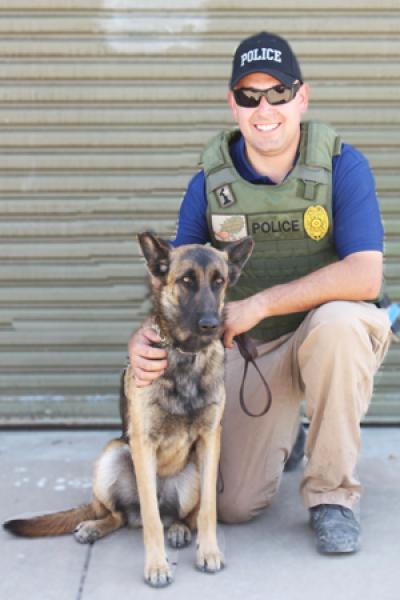NMSU Police Department trains three new K-9 officers

The dogs are Quinty, a Belgian Malinois from the Netherlands; Ray a Belgian Malinois from the Netherlands and Raven, a Belgian Malinois-German Shepherd cross, who was donated to the university by Jacob Ballard from the Dona Ana County Sheriff's Department. All three dogs are trained in Dutch. Quinty and Ray were acquired through a grant from the Department of Homeland Security.
Officer Sakarias Ottersland is Quinty's handler; Officer Jasper Domenici works with Raven, but is also training Ray, until Officer-in-Training Ryan Beck, Ray's handler, completes his field training. Beck joined the department as an officer-in-training in June.
Though the dogs have been through varied types of training prior to their arrival at NMSU, they started a standard four-week basic class with their handlers once they arrived.
"We basically try to train in environments where we believe we will deploy our dogs," said Andy Bowen, New Mexico State University interim deputy chief of police. "We do detection training, they have to go through a four-week basic class, and at the end of the basic class, the handler has to pass a written test. Both handler and dog must pass a practical test."
Bowen, who was Rio's first handler, says that NMSU K-9s are trained in vehicle, building and area searches, and trained heavily in venues they will be deployed in for bomb sweeps prior to large events on campus. The dogs are used to help ensure the safety of those on campus for regular day-to-day business and for special events like concerts, graduations and sports events.
Training, like the searches the teams will do once certified, are methodical. Domenici describes his method of searching a room with Raven.
"My first pass around the room, I do a scan, which basically means I let the dog go wherever she wants to go. Anything that interests her, or just grabs her attention, she'll work it out," Domenici said. "If we go through that room and don't find anything, we go through a second time and do a systematic search."
Training dogs takes time and patience, whether the dog is a family pet, or a K-9 officer, and that training also takes some kind of reward system to reinforce positive behaviors.
"This is everything to her," Domenici said, holding up Raven's reward, an orange and blue tennis ball, attached to a short blue rope. "This is the whole reason she does what she does."
When the K-9s find the training aids hidden by trainers, the handler presents the dog's reward and plays with the dog for a couple of minutes, using the "high, happy" voice, also very pleasing to the dogs. Domenici explained that there are two commonly used ways of presenting the reward - and in doing so, reinforcing that the dog found the training aid, which in a real-world situation, could mean the difference in life or death of many people at an event. The NMSU K-9 handlers either present the reward palm out, so it is hidden behind their hand, holding it up next to the training aid, then dropping it, or they throw the reward at the training aid. Either method typically results in a chaotic, happy celebration between human and K-9.
Though training will be ongoing, Ottersland and Quinty certified last week and the other teams will soon follow.
Bowen said that like Rio, Quinty, Raven and Ray will often be out and visible at community events, as four-legged ambassador's of the NMSU Police Department.


